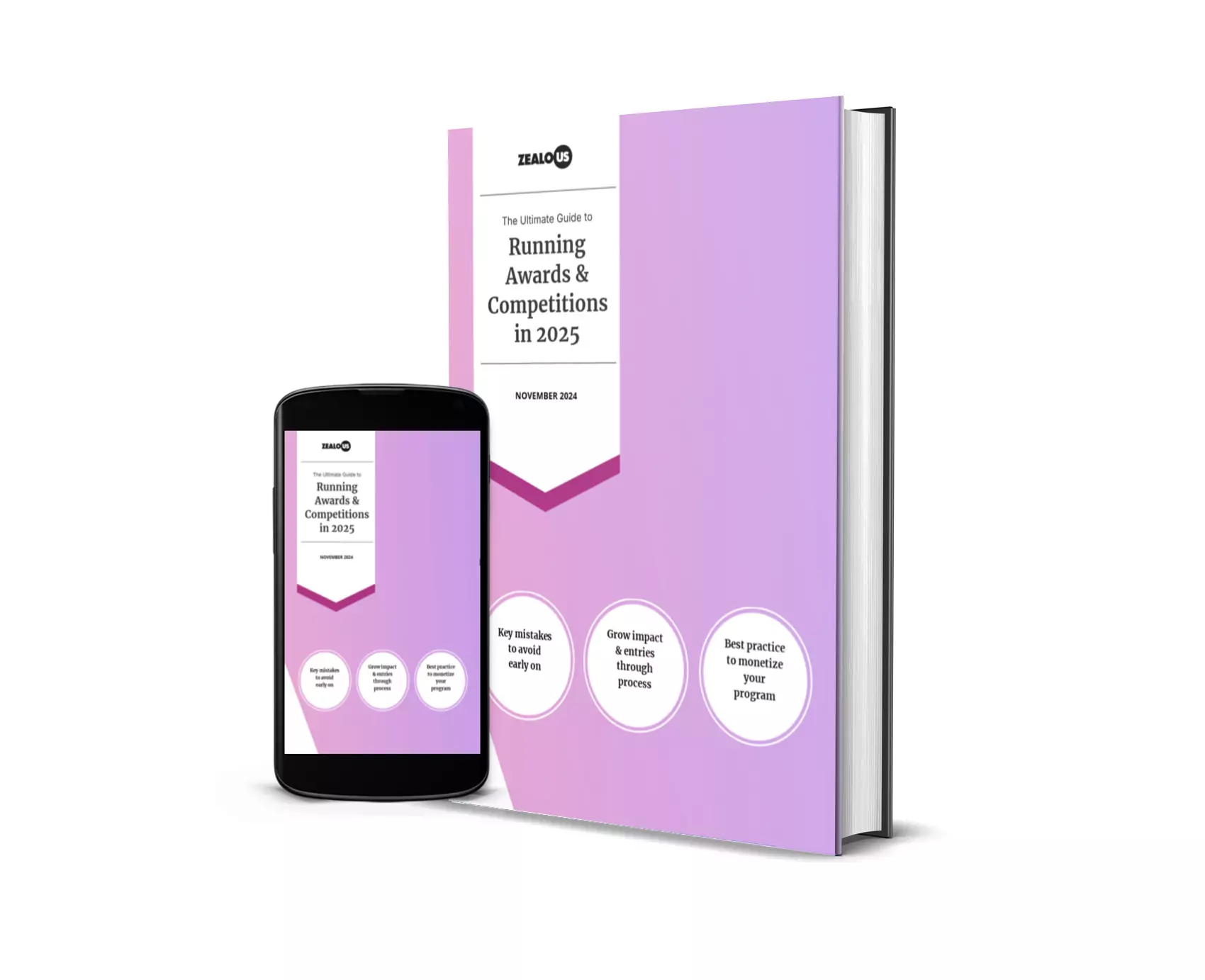This article covers:
Pricing is one of the trickiest decisions you’ll make when running awards or competitions. It sits at the uncomfortable intersection of sustainability and access, revenue and inclusion, pragmatism and idealism.
Set fees too high and you exclude talented candidates who need your opportunity most. Too low and you risk your organisation’s financial health. Somewhere in between lies a pricing strategy that serves both your program and your community.
This isn’t just theory. Pricing affects every aspect of your complete award management strategy: from how many submissions you receive to who feels welcome applying, from your cash flow timing to your administrative burden.
The good news? The decision needn’t be black and white. Alternative pricing models exist that let you embrace multiple approaches simultaneously, lowering barriers whilst maintaining revenue.
To Charge, or Not to Charge
Choosing to charge candidates is a big decision. It’s a delicate balance between future-proofing your organisation and making your opportunity accessible to those who can’t afford the fee.
The relationship is simple: larger submission fees mean fewer applications. But free submissions can swamp you, and without the right process, lead to heavy administrative overheads that consume the time you’d save on revenue.
Luckily, several models exist beyond the binary free-or-paid choice:
- Donations (optional payments): Let candidates choose what they can afford, including nothing
- Early bird fees: Make submissions cheaper when candidates apply earlier
- Bulk discounts: Offer better rates for multiple submissions
Each model has distinct advantages. We’ll explore them individually later in this article.
Fostering diversity & inclusion
Making fees optional allows more people from lower socio-economic backgrounds to participate in your program. Even candidates who can afford fees appreciate the flexibility and trust this approach signals.
Download launch checklist
Never miss a critical step: 300+ tasks across 8 phases, from securing judges to winner announcement.
Pricing It Right
Your first step is to understand who you wish will submit and their circumstances.
If most of your target candidates struggle to pay anything, you’ll need alternative funding sources and should keep submissions free. You might also consider optional donations instead.
If charging feels right, determining “how much” becomes the challenge. What will candidates need to sacrifice to pay your fee? A couple of coffees (£5)? Weekly grocery shopping (£40 average in the UK)? More?
Three approaches help establish your baseline:
- Work backwards: Calculate total program costs, divide by expected applications, then add 30% contingency. This gives you the minimum fee needed to break even.
- Follow competitors: Research similar programs in your field and price accordingly. You’re not copying. You’re understanding market expectations.
- Ask your community: Tell a select group what you’re organising and ask if they’d pay £X. Start deliberately high to gauge reaction, then ask what they would pay. This reveals honest answers.
Quick Pricing Calculation
Program costs: £2,000 (venue, prizes, admin time). Expected submissions: 150. Contingency (30%): £600. Total needed: £2,600.
£2,600 ÷ 150 = £17.33 per submission. Round down to £15 for accessibility. Consider tiered early bird (£8/£12/£15) to maintain access whilst hitting revenue targets.
Using a mixture of these approaches gives you an average price: your reference point when working out special deals, donations, or tiered structures.
Before finalising, sanity check your price with two critical questions:
- Will the communities I’m reaching be able to afford this fee?
- How many submissions do I need at this price to break even or reach my target?
Edit accordingly.
Real-World Pricing Benchmarks
Looking at what others charge provides useful context. Here’s what successful programs typically ask:
Photography awards often charge £15-30, with prestigious international competitions reaching £40-50. Writing competitions generally sit lower at £5-15 per submission or £20-25 for multiple entries. Design and innovation awards span £10-40 depending on category and prize value. Student-focused programs typically charge £5-10 or remain free with institutional support.
The pattern? Higher-profile judges, larger prizes, and established reputations justify premium pricing. Newer programs building credibility start lower (£5-12) and grow fees as reputation strengthens. Geographic location matters too. North American awards often charge $25-50 where UK equivalents ask £10-20.
Use these ranges as reference points, not rules. Your community’s circumstances matter more than industry averages.
Fostering diversity & inclusion
Seemingly small price changes can dramatically affect access. The difference between £8 and £10 might feel negligible to you, but for candidates with limited resources, £2 can make or break a submission decision. Price as low as your model allows.
Get Buy-In
When candidates consider applying, they’re asking themselves three questions:
- Do I trust this opportunity?
- Is this value for money?
- Can I afford it?
Convincing candidates to spend hard-earned money anchors heavily on clear, concise communications about your brand and what candidates gain from selection.
Higher fees require a better offering: bigger prizes, higher-profile judges, stronger career benefits. Having recognisable judges on your panel justifies premium pricing and attracts quality submissions. Publish as much detail as possible about what candidates receive. Don’t spare specifics.
Show, Don’t Tell
Compare these approaches:
Needs improvement
“Be published in our magazine”
Good
“Be published in our physical magazine (readership of 15,000) and have your story shared across our social media networks (152,000 Instagram followers, 87,000 Facebook)” with links to the networks as proof.
Needs improvement
“Have your work seen by the industry”
Good
“Have your work seen by the arts editors of Vice, Creative Boom and the FT”, with links to tweets from these individuals acknowledging their excitement to participate.
Specificity builds trust. Vagueness breeds scepticism.
Communicate Value Transparently
When presenting pricing on your award pages, clarity matters. Display fees prominently early in the candidate journey. Surprises at checkout feel like bait-and-switch tactics.
If using tiered pricing, explain the structure clearly: “£8 before 3 May, £12 before 15 May, £15 after.” Make the value proposition obvious for early submission.
For programs with fees, consider explaining briefly how submission revenue supports the initiative. Candidates feel better about fees when they understand funds maintain quality judging, enable larger prizes, or expand program reach.
Transparency about fund usage converts hesitant candidates into willing participants.
Remove Friction
Adding payment steps to your submission process can confuse candidates with a patchwork of services to navigate.
Consider this common scenario:
- View competition page
- Visit payment site (PayPal, Stripe)
- Create account or login
- Make payment
- Copy transaction ID
- Navigate to application form (JotForm, Google Forms)
- Fill out form
- Paste transaction ID
Each additional step loses candidates. You’ll also waste time on bloated administration: matching payments to submissions, handling refunds, chasing missing transaction IDs.
Grow submissions, raise more funds, and simplify admin by choosing a service that seamlessly integrates payments within the application process.
Streamlined process:
- View competition page
- Register or login
- Fill out form
- Make payment (within same system)
Modern award platforms integrate payments directly within the submission workflow: eliminating the need to juggle PayPal tabs, copy transaction IDs, or manually match payments to applications.
Payment Methods Matter
Accept multiple payment options to avoid losing candidates at the final step. Card payments (Visa, Mastercard, Amex) should be standard. PayPal works for candidates without cards or those concerned about security. For international awards, consider currency conversion. Charging in multiple currencies reduces friction and hidden fees that deter applications.
Display security badges prominently. Candidates need assurance their payment information is safe. Mention PCI compliance if your system has it. For higher-fee programs (£30+), consider offering payment plans or instalments.
When Payments Fail
What happens when a card is declined? Automated retry systems catch temporary declines without losing submissions. Clear error messages (“Card declined: please try another payment method”) help candidates resolve issues immediately rather than abandoning applications.
Modern platforms handle these scenarios gracefully, turning potential dropouts into successful submissions. They also track partial submissions, allowing candidates to save progress and return to complete payment later without re-entering information.
Have a clear refund policy and display it prominently. Knowing they can get money back if circumstances change reduces candidate anxiety about committing fees. Transparent refund terms build trust, even if few candidates actually request refunds.
Fostering diversity & inclusion
Complex payment processes alienate communities who struggle with technology, have limited time to apply, or have specific accessibility needs. Streamlined, integrated systems lower barriers for everyone.
Want more articles like this?
Give this one a like
Get the Timing Right
Although the creative industries operate as a gig economy, most professionals still depend on stable work with regular paycheques. Your candidates likely have repetitive cash flow cycles.
When you close your submissions will impact whether candidates have money available to submit. Strategic timing matters:
- Close submissions just after payday (usually the last Friday of the month). Candidates have cash in hand and haven’t yet allocated it to other expenses.
- Watch out for capital-intensive periods in your communities’ calendars: religious festivals, holidays, back-to-school, tax deadlines. If your deadline falls during these periods, extend by one or two pay cycles. You don’t want candidates choosing between your submission fee and Christmas, Eid, Hanukkah, Diwali, or other essential expenses.
Understanding your communities’ financial rhythms transforms pricing from a barrier into a thoughtful accommodation.
Fostering diversity & inclusion
Understanding when your communities’ expenses peak across the year removes the additional stress of choosing between your program and essential costs. It’s a small consideration with significant impact.
Rewarding Early Birds
Offering better prices for early submissions solves multiple problems simultaneously:
- Earlier cash flow: Get funds in the bank sooner by inspiring candidates to submit before the deadline. Research shows 70-80% of applications arrive in the final couple of days. Early bird pricing redistributes this curve.
- Greater accessibility: Candidates with fewer resources can afford your opportunity if they submit earlier.
- Revenue protection: Keep higher fees that allow you to run your program effectively without excluding communities.
Example tiered structure:
- £5 before 3 May (Monday after payday)
- £10 before 15 May
- £25 after 31 May (Monday after payday)
The most effective award management systems let you test multiple pricing strategies without technical work: switching between donations, tiered pricing, or early bird models based on what resonates with your community.
Fostering diversity & inclusion
Offering free or heavily discounted prices for early submissions ensures you don’t price communities out whilst maintaining the revenue needed to run quality programs.
Donations & Tips
If you receive public funding, taking mandatory fees often isn’t an option. But this doesn’t mean you can’t create revenue streams to sustain your efforts.
Allowing candidates to donate fixed amounts whilst submitting generates additional revenue to support your program without creating mandatory barriers.
Example pricing package:
- Free submission (default)
- £3 donation
- £5 donation
- £10 donation
This model works surprisingly well. Candidates who can contribute often choose to support programs they value. Those who can’t afford donations still have full access. Everyone wins.
Platforms purpose-built for awards automatically track revenue by pricing tier, submission date, and payment method: saving hours of spreadsheet work and providing instant financial clarity.
Fostering diversity & inclusion
Removing mandatory submission fees guarantees no one is priced out and helps make a positive case for publicly funded organisations continuing to support creative opportunities.
Insights like these straight to your inbox
Receive weekly tips from our founder to grow your program’s impact; regardless of what tools you use.
Bulk Discounts
Creating incentives to submit multiple times allows you to raise more funds whilst increasing candidates’ chances of selection for less money.
The steeper the discount, the more likely you are to upsell additional submissions to candidates. More applications helps when making the case to sponsors and supporters for future programs: demonstrating strong engagement and community interest.
Example structure:
- One submission: £8
- Three submissions: £16 (three for two)
This model works particularly well for photography, design, or art competitions where candidates naturally have multiple pieces they might submit.
Fostering diversity & inclusion
Worth noting: special deals still favour those with more resources and won’t make submitting more accessible to lower-income individuals. Consider combining bulk discounts with other inclusive pricing models like donations or early bird options.
Finally
As inequality widens across society, pricing becomes increasingly contentious and complex.
Price yourself too high and you remove opportunity from those who may need it most. Price yourself too low and you risk your organisation’s sustainability. The tension between these positions is real and uncomfortable.
Serving both imperatives requires thinking beyond traditional “pay to play” models. A thoughtful balance of alternative approaches: donations, early bird offers, tiered structures, transparent communication. This allows those with resources to generate revenue whilst guaranteeing those without still have access to opportunities that could enrich their futures.
Award platforms committed to inclusion make pricing optional at the system level, automate fee waivers for qualifying candidates, and display pricing clearly in multiple currencies: removing barriers systematically rather than case-by-case.
Three questions to ask before finalising your pricing:
- Who am I excluding with this price, and is that justified?
- Have I explored every alternative model that might increase accessibility?
- Am I timing fees to work with my community’s financial rhythms rather than against them?
Getting pricing right isn’t about perfection. It’s about making thoughtful decisions that balance sustainability with access, then iterating based on what you learn from each program you run.
We can help!
Zealous makes taking submissions seamless
But we’re not alone in the space – here are 8 others you may wish to consider (even if we would prefer you choose us!).
Want us to write more content like this? Give it a like
Share

Guy Armitage is the founder of Zealous and author of “Everyone is Creative“. He is on a mission to amplify the world’s creative potential.
Frequently Asked Questions
How much should I charge for competition submissions?
Start by calculating your program costs and dividing by expected submissions (add 30% contingency). Then compare with similar competitions in your field. Most creative awards charge between £5-25, with £10-15 being the sweet spot for accessibility.
Always consider early bird discounts to lower the barrier whilst maintaining revenue. The right price balances sustainability with inclusion.
Should awards and competitions be free to enter?
Free entry maximises accessibility and submission numbers, but can be unsustainable without alternative funding. Consider hybrid models: free base entry with optional donations, or free early bird submissions with later fees. If you have public funding, free entry may be required.
The key is finding a revenue model that doesn’t exclude talented candidates who can’t afford fees.
What is early bird pricing for competitions?
Early bird pricing offers discounted submission fees for candidates who apply early. For example: £5 before early May, £10 mid-May, £25 after late May. This strategy generates earlier cash flow, rewards organised applicants, and maintains accessibility whilst keeping higher fees for late submissions.
It solves the problem of 70-80% of applications arriving in the final days.
How do I price awards without excluding lower-income candidates?
Use inclusive pricing strategies: make fees optional (donations model), offer free or heavily discounted early bird rates, provide fee waivers for specific communities, or keep base fees minimal (under £10). Time your deadline after paydays (usually month-end).
Avoid closing during expensive periods like holidays. Even small price changes (£1-2) can significantly impact accessibility.
What are alternative ways to generate revenue from awards besides entry fees?
Beyond mandatory fees, consider: optional donations at submission (£3, £5, £10 tiers), bulk discounts (3 for 2 deals), sponsorships, partnerships, grants, crowdfunding, or post-selection monetisation (exhibition sales, publication fees).
Donation models work well for publicly-funded organisations that can’t charge mandatory fees whilst still generating support from those who can contribute.
When should competition submissions close to maximize paid entries?
Close just after payday (typically the last Friday of the month) when candidates have cash available. Avoid periods with high expenses: Christmas, religious festivals (Eid, Hanukkah, Diwali), back-to-school, or major holidays.
If these fall near your ideal deadline, extend by one or two pay cycles. Understanding your community’s financial rhythm reduces the stress of choosing between your award and essential expenses.
How can I reduce friction in the award payment process?
Integrate payments directly within your submission process. Avoid making candidates juggle multiple platforms (PayPal, separate forms, transaction IDs). A streamlined process: view competition → register → fill form → pay in one flow.
Each additional step loses candidates and creates administrative work matching payments to submissions. Modern awards platforms handle this seamlessly, reducing dropout and admin overhead.









